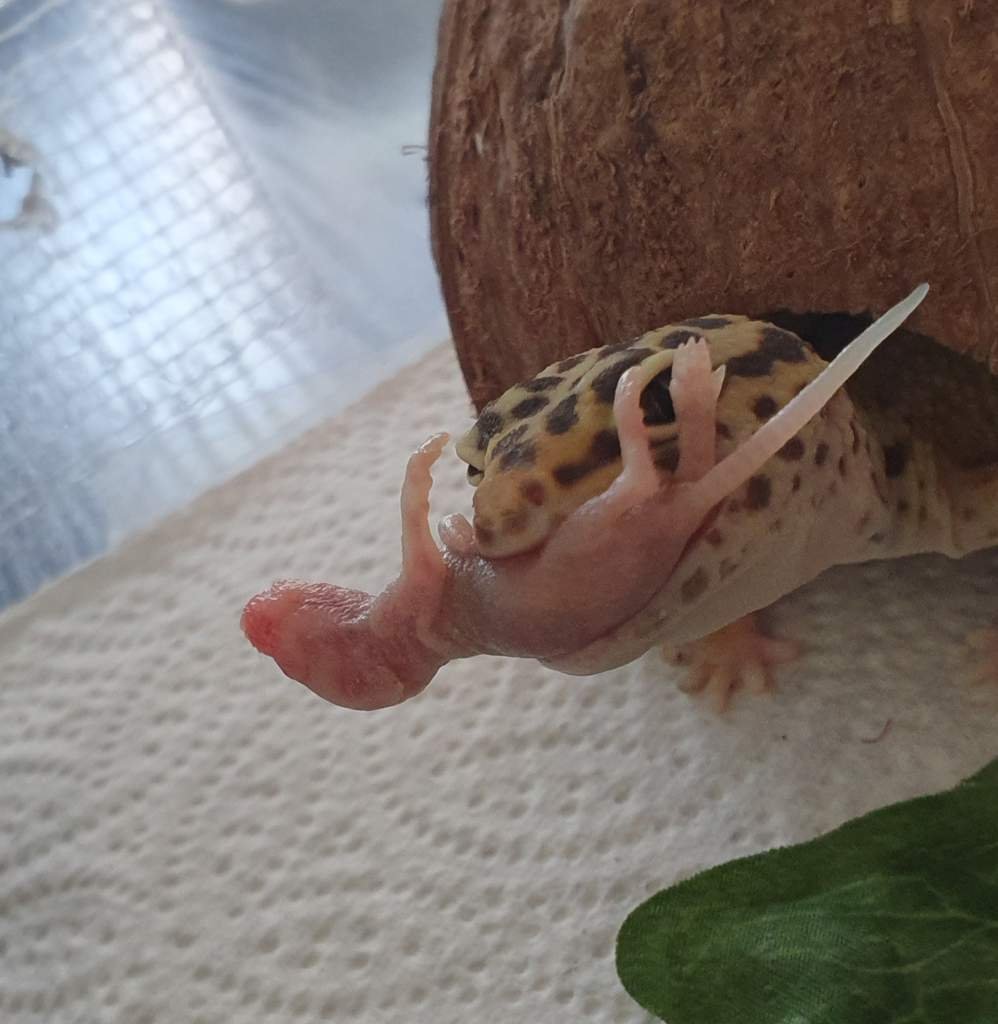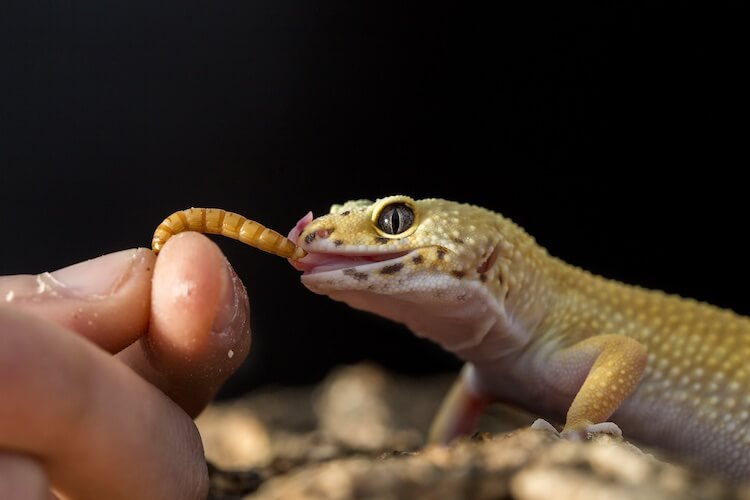Why Can’T Leopard Geckos Eat Pinky Mice

Leopard geckos are not able to eat pinky mice because their digestive system is not designed to digest mammalian meat. Leopard geckos are insectivores, meaning that their diet consists primarily of insects. While pinky mice may be a good source of protein for other animals, they can actually cause health problems for leopard geckos.
In some cases, eating pinky mice can even be fatal.
If you’ve ever wondered why leopard geckos can’t eat pinky mice, wonder no more! The simple answer is that their stomachs are not designed to digest them properly. Leopard geckos are insectivores, meaning their diet consists mainly of insects.
While they can technically eat pinky mice, they will have a lot of difficulty digesting them and may even end up getting sick as a result. So if you’re looking to give your leopard gecko a healthy diet, stick to feeding them insects instead of pinky mice!

Credit: www.everythingreptiles.com
Can My Leopard Gecko Eat a Pinky Mouse?
Yes, your leopard gecko can eat a pinky mouse. In fact, this is one of the most common food items that leopard geckos are fed. Pinky mice are young mice that have not yet reached sexual maturity.
They are small in size and have very little fur. Leopard geckos tend to prefer pinky mice that are no more than one-third their own body size. If you are unsure of how big your leopard gecko is, you can always err on the side of caution and go for a smaller pinky mouse.
When it comes to feeding your leopard gecko, it is always better to err on the side of caution than to overfeed them and cause them health problems further down the road.
Can Leopard Geckos Eat Frozen Pinkies?
If you’ve ever wondered if your leopard gecko could survive on a diet of only frozen pinkies, you’re not alone. It’s a common question among reptile enthusiasts, and the answer is yes! Your leopard gecko can safely eat frozen pinkies.
Frozen pinkies are actually a very convenient food source for leopard geckos. They can be stored for long periods of time and thawed as needed, making them ideal for busy reptile owners. Plus, they offer all the nutrients your gecko needs to stay healthy.
Of course, you’ll want to take some precautions when feeding your gecko frozen pinkies. First, make sure the pinkies are properly thawed before offering them to your pet. Second, avoid giving your gecko too many pinkies at one time – stick to one or two per week as part of a well-rounded diet.
And finally, don’t forget to provide plenty of fresh water for your pet to drink!
What Food is Toxic to Leopard Geckos?
There are a few foods that are toxic to leopard geckos, and it’s important to be aware of them so you can avoid feeding them to your pet. The most common toxic food for leopard geckos is chocolate. Chocolate contains a compound called theobromine, which is poisonous to leopard geckos (and many other animals).
Symptoms of chocolate poisoning in leopard geckos include vomiting, diarrhea, tremors, seizures, and death. Other foods that are toxic to leopard geckos include onions, garlic, avocado, and caffeine. Feeding any of these foods to your leopard gecko can cause illness or even death, so it’s best to avoid them altogether.
Can Day Geckos Eat Pinkies?
Yes, Day geckos can eat pinkies. In the wild, these lizards typically eat insects and other small invertebrates. However, captive day geckos will accept a wide variety of food items, including pinkie mice.
When offering pinkies to your day gecko, be sure to gut-load the mice first by feeding them a nutritious diet for several days prior to offering them as prey. This will help ensure that your lizard gets the nutrients it needs from its meal.
Leopard Gecko Gobbles Down A Pink Mouse / Warning Live Feeding
Can Leopard Geckos Eat Fruit
Leopard geckos are interesting lizards that are native to parts of Asia and Africa. In the wild, these geckos eat a variety of insects, but in captivity, they are often fed a diet of commercially-prepared food pellets or live insects. Some keepers like to supplement their leopard gecko’s diet with fruit, but is this really a good idea?
Fruit is not a natural part of a leopard gecko’s diet, so it is not something that they are adapted to eating. Fruit is also relatively high in sugar, which can lead to health problems for leopard geckos if they eat too much of it. If you do decide to feed your leopard gecko fruit, it should only be offered as an occasional treat and in very small quantities.
Live Pinky Mice for Sale
Looking for a unique pet? Why not consider a pinky mouse? These little rodents are not only adorable, but they make great pets.
Here’s everything you need to know about pinky mice.Pinky mice are a type of albino mouse that is characterized by its pink or reddish fur. These mice are typically born without eyes, but they can see after a few weeks.
Pinky mice are very active and playful, and they love to explore their surroundings.Pinky mice make great pets because they are very social creatures. They enjoy being around people and other animals, and they bond easily with their owners.
Pinky mice are also relatively easy to care for – all they need is a clean cage, fresh water, and plenty of food and toys to keep them entertained.If you’re interested in adding a pinky mouse to your family, there are several things you need to keep in mind. First, pinky mice do best in pairs or small groups – so be prepared to house more than one if you decide to adopt them.
Second, these little rodents have sharp teeth so it’s important to provide them with plenty of chew toys (and avoid letting them nibble on your fingers!). Finally, like all animals, pinkies require regular vet check-ups to ensure they stay healthy and happy.If you’re looking for an unusual yet lovable pet, look no further than the pinky mouse!
With their cute appearance and fun personality, these furry friends are sure to bring joy into your home.
Do Geckos Eat Mice
Geckos are carnivorous lizards that feed on a variety of small animals, including insects, spiders, and other lizards. Some species of gecko will also eat small mammals such as mice. In the wild, geckos typically hunt at night, using their keen sense of smell to track down prey.
Once they find their target, they use their long tongues to capture and consume it.While most geckos are too small to pose a threat to adult mice, newborn or juvenile mice may be at risk of becoming prey. In captivity, however, some geckos have been known to attack and eat full-grown mice.
If you have pet geckos and are concerned about them harming your mouse population, you can take steps to protect your animals by keeping them in separate cages or housing them in different areas of your home.
Can Darkling Beetles Be a Safe Food Source for Leopard Geckos?
Leopard geckos and darkling beetles form a mutually beneficial relationship. Darkling beetles provide a safe and nutritious food source for leopard geckos, offering essential proteins and fats. As natural scavengers, darkling beetles are readily available and easy to breed, making them an ideal prey for leopard geckos.
Can Bearded Dragons Eat Pinkies
As most pet owners know, bearded dragons are omnivorous lizards that require a diet of both vegetables and meat. While adults typically eat larger insects and pinky mice, baby dragons usually subsist on smaller prey items like crickets and mealworms. But what about when they’re in-between?
Can bearded dragons eat pinkies?The answer is yes, but with a few caveats. First of all, only feed your dragon pinkies that are no bigger than the space between their eyes.
Secondly, make sure to remove the mouse’s head and tail before giving it to your pet – these can be sharp and pose a choking hazard. Finally, don’t overdo it – while protein is an important part of a beardie’s diet, too much can lead to health problems down the road.So there you have it – Pinkies are definitely on the menu for bearded dragons!
Just remember to use moderation and always err on the side of caution when feeding your pet.
Conclusion
There are a few reasons why leopard geckos shouldn’t eat pinky mice. First, pinky mice are too small and can easily become lodged in a leopard gecko’s throat. Second, pinky mice are not a natural part of a leopard gecko’s diet and may not provide the nutrients they need.
Finally, pinky mice can carry diseases that could be harmful to leopard geckos. If you’re looking for an appropriate food source for your leopard gecko, consider crickets or mealworms instead.